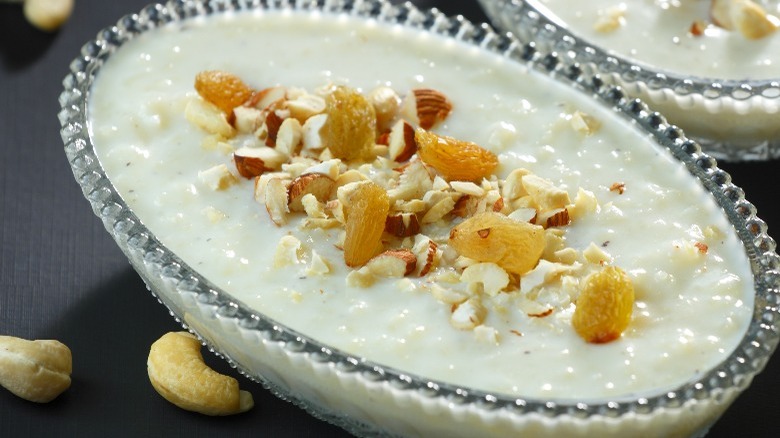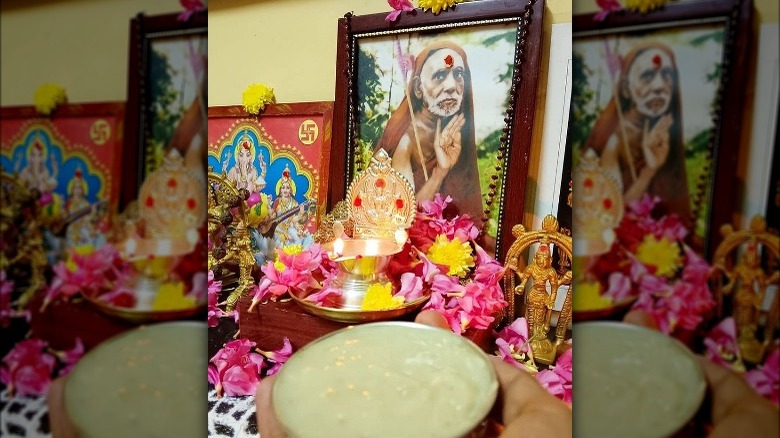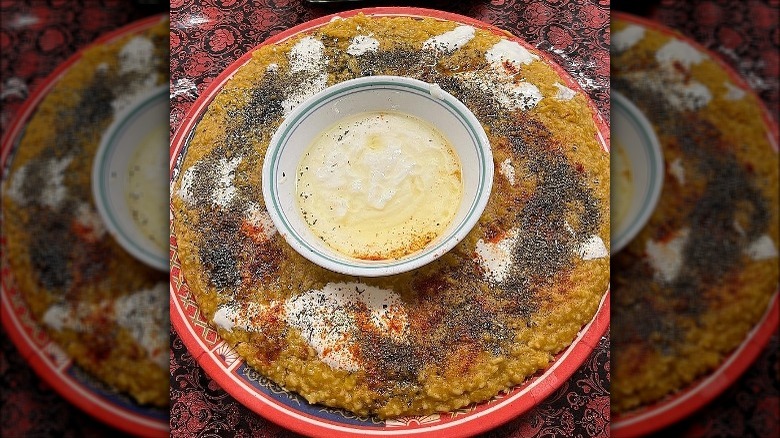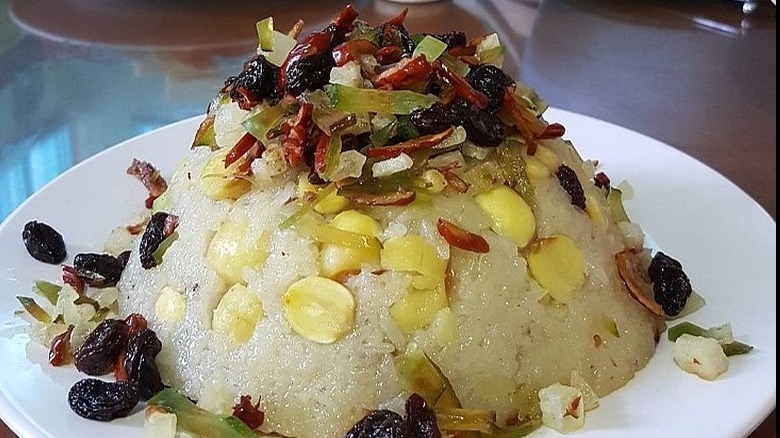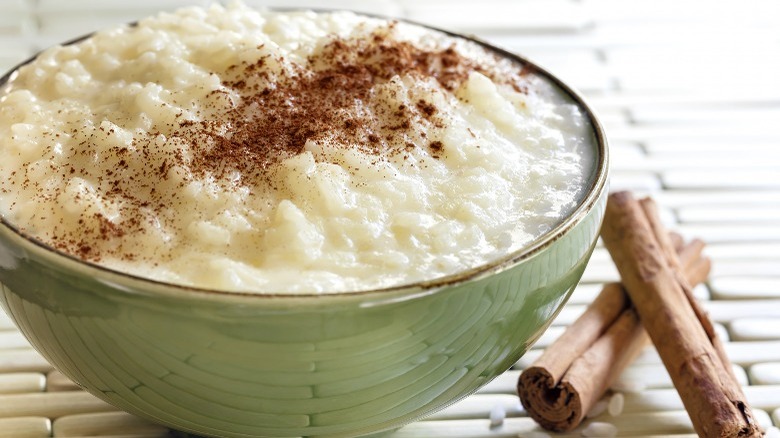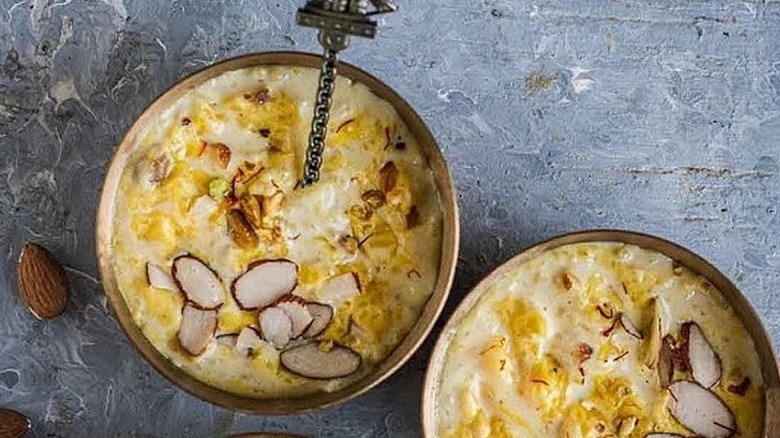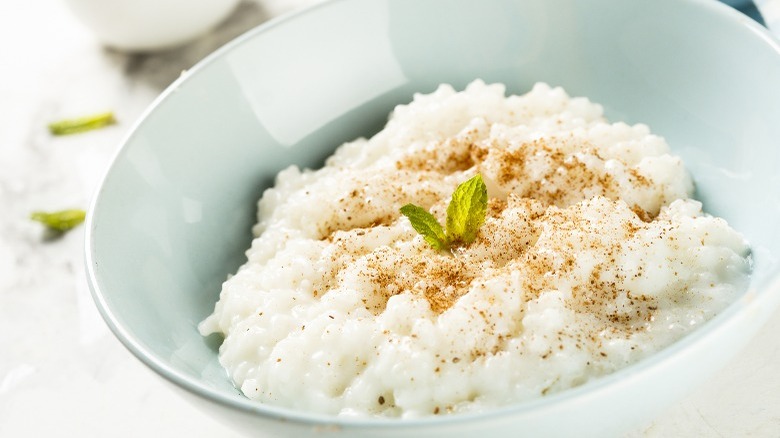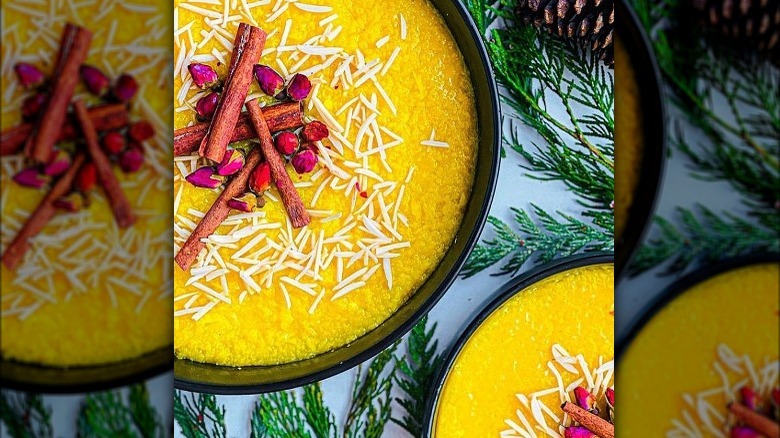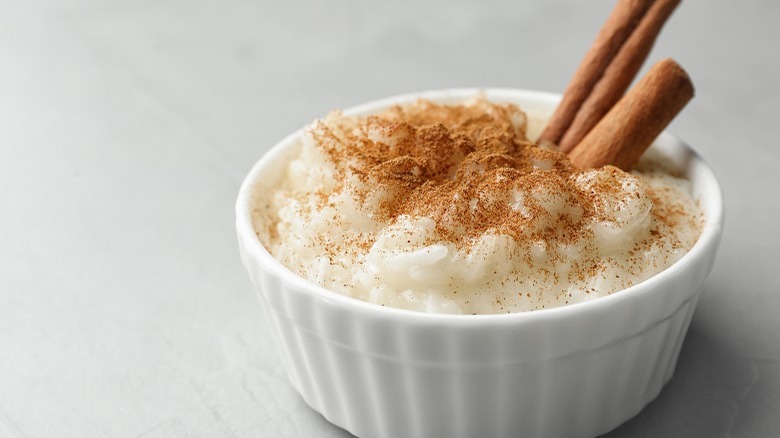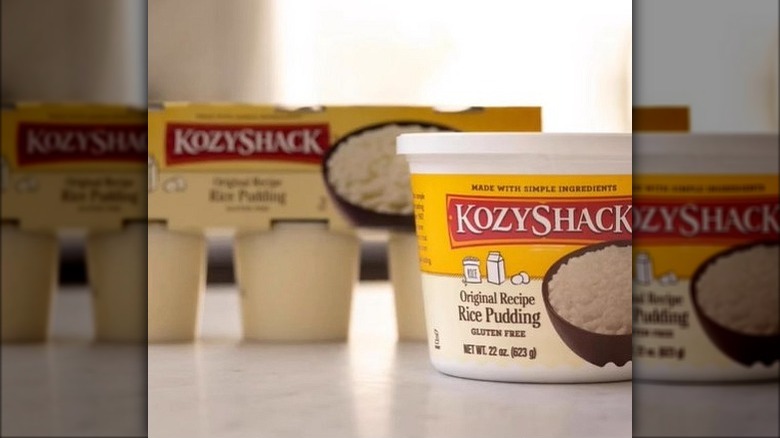People Have Been Eating Rice Pudding Since The Dawn Of Time
Rice pudding, kheer, payesh, muhalabia, arroz con leche — whatever you call it — this indulgent, creamy dessert, has been around in many forms, and in many countries, for over 8,000 years. Traditionally made with rice, sugar, and some form of milk, rice pudding has stood the test of time.
Travel with us from ancient Rome to China and from Indian temples to the Middle East. Stop to take in some of the variations you'll find in rice pudding recipes worldwide. From its roots as an offering to Hindu deities and as medicine for the sick to its popularity with the rich for celebrations such as weddings, rice pudding certainly has a diverse and interesting history. We'll dive deep into its global origins, with stories surrounding its roots from around the world.
Then we'll take a look at some of the wonderful recipes for rice pudding that exist today, from Peru's arroz zambito to France's riz au lait, and Germany's milchreis (with its special rice) to Mexico's arroz con leche, made with condensed milk. Finally, we'll decide whether homemade rice pudding or store-bought is best and look at some of the best readymade brands to try when you simply don't have time to whip up your own rice pudding at home.
The global origins of rice pudding
People from the U.K. will tell you rice pudding was first invented there. Yet speak to any Indian person and they'll tell you it's an authentic Indian dish. People from China, Greece, Italy, and Mexico will tell you the same thing. Germans will swear that they invented the first rice pudding.
Though we may never really know exactly where rice pudding first originated, from what we do know, it has its roots in India and China many thousands of years ago. It's thought to have come to Europe around the 14th century. However, it was around even earlier as a type of rice pottage used medicinally for stomach upsets in Roman times.
Rice pudding's origins are a mystery that may never be solved, but there are many interesting stories from around the world surrounding its history. Let's dive into some of the most fascinating legends, starting with the tale of rice pudding and a Hindu deity in India, and stopping off in the Middle East, where it was once used medicinally, before traveling to China for a story about rice pudding and Emperor Zhou.
Rice pudding and Hindu deities
Though there's no one true origin story for rice pudding, we can date its roots back to 6,000 B.C. It was at this time it was first mentioned, as ksheer or kshirika, forever linked to the tale of Krishna, the Hindu deity.
The story goes that Krishna challenged the king of Ambalapuzha to a chess match. Showing himself as a sage, the deal was that if Krishna won, he'd be granted one grain of rice for the first chessboard square and two for the second, with the amount doubling per square. Confident he would be the victor, the king readily agreed to this deal. Sadly, the sage beat the king, who ended up owing the deity huge quantities of rice. The sage revealed himself as Krishna and told the king that instead of paying up what he owed in rice, he could instead serve payasam to pilgrims visiting Krishna's temples.
To this day, Ambalapuzha paal payasam (rice pudding) is served to pilgrims visiting temples not only in Ambalapuzha but across India. It's also a popular dish outside temples, served at weddings and celebratory occasions nationwide.
Middle Eastern medicinal rice pudding
Outside of India, the first mention of rice pudding in the Middle East was in medical texts. Due to its simple, relatively bland ingredients and soft texture, it was a dish that was both nutritious and easy to digest.
Soon, rice pudding became a popular dish with royalty, served at special occasions such as parties and weddings. Today, it lives on in the form of shola, which can be either a savory or sweet dish. Savory shola is made with short-grain rice and usually has a sticky, risotto-like consistency. Traditional recipes include split chickpeas or mung beans, onions, dried herbs, garlic, onions, and a selection of spices, including paprika, cumin, and turmeric. You'll often find this served with a chickpea-based tomato sauce topping and tangy garlic yogurt on the side. Some versions also add meat such as lamb or beef.
Sweet shola is made with short-grain or glutinous rice and usually some type of milk. Shola-e-zard incorporates rosewater or orange flower water and saffron for a delicate flavor. Surti sweet shola, most commonly served on Eid or other special celebrations in India, colors the rice yellow with the addition of turmeric and saffron and includes almonds, cashews, raisins, dried apricots, lemon, and sugar, with spices such as cloves, cinnamon, and cardamom.
The overthrowing of Emperor Zhou
Though it may never be proven, many historians will tell you that rice pudding originated in China. Today, Chinese rice pudding is also known as Eight Treasure Rice Pudding or Eight Jeweled Rice Pudding.
The legend behind this dish tells of the tale of Emperor Zhou. The story goes that King Wu, a neighboring rival emperor, hired eight scholars to overthrow Zhou. When they returned to Wu's kingdom to regale the emperor with stories of their bravery, he rewarded them with the "Eight Treasures" dessert. Another tale claims that rice pudding was once a secret family recipe in the Qing Dynasty. It's said that an enterprising lawyer stumbled across the recipe and took it as a birthday gift to a queen who had recently lost her husband. She fell instantly in love with the dish and promoted the lawyer.
Whatever the true history behind Chinese rice pudding, it's always made with sticky or glutinous rice, incorporating various fruits and raisins soaked in honey, as well as nuts, hence the name Ba Bao Fan, meaning "Eight Treasures." Often served on Lunar New Year, this delectable dessert bears little resemblance to the creamy rice pudding we enjoy in the U.S. The fruit and nuts give it an aromatic, sweet flavor, with some recipes also including red bean paste.
Rice pudding and the Romans
Though it's thought that rice pudding didn't reach Europe until the 14th century, evidence of a similar rice-based pudding can be found dating back as far as Roman times. The Romans used these rice pottages medicinally, to settle upset tummies caused by overindulging in meat and wine.
These pottages used boiled rice, sugar, and cow's or goat's milk and were soothing, nutritious, and easy to digest. Recipes for baked rice puddings didn't begin to appear until later, around the time of the 17th century. These were richer dishes that often added extras such as eggs and breadcrumbs to the milk, sugar, and rice base. The average Roman wouldn't have indulged in such luxuries, as rice was imported at the time and extremely expensive. Rice pudding as an upset stomach remedy was therefore reserved for the wealthiest members of Roman high society. It may also have been served on special occasions, as we're about to see.
Rice pudding for special occasions
With the cost of importing rice sky-high, rice pudding remained a luxury in Europe for some time. But this dish wasn't always an indulgent sweet treat.
Throughout the Middle Ages, rice pudding was more commonly served as a savory side dish, similar in style to risotto. One recipe in England's oldest surviving cookbook, "The Forme of Cury," dating back to the 1390s, uses saffron, almond milk, and salty meat broth.
By the 15th century, sweet versions of rice pudding began to emerge. Most used suet to hold the pudding together, stuffing it into skins for boiling. Ingredients included sugar and honey, with spices such as cinnamon, nutmeg, and mace, and fruit such as currants or dates. Many recipes also added eggs, which gave the boiled pudding a rich flavor. It wasn't until the 17th and 18th centuries that rice pudding became a common dessert in the U.K. Even then, it was still only served at celebratory occasions such as weddings or to mark special holidays.
From posh to everyday: Rice pudding's rise in popularity
As importing rice became more common — and more affordable — rice pudding became more of an everyday dessert. In the 19th century, it was mentioned by Mrs. Beeton, an English journalist best known for her books on cookery and household management, as economical and "good for the nursery."
In the 20th century, rice pudding was also served in hospitals and schools across the country and earned its hard-to-shift reputation for being plain. Since it was made simply with milk (or milk and water), short-grain rice, and sugar, it's easy to see why it was hardly considered a luxury. The savory version first mentioned in "The Forme of Cury" was also popular throughout the 1950s, cooked with broth and often served under a joint of meat.
Since these humble beginnings, rice pudding's popularity has continued to grow and it has become a staple dish in many cuisines around the world. You'll find versions of rice pudding in almost every country, from India and China to Mexico and Portugal.
Rice pudding around the world
Different countries around the world each have their own unique takes on rice pudding. In the Middle East and Iran, you'll see it called shola, which can be sweet or savory. Travel to Peru, and you'll be served arroz zambito. This rice dessert is enhanced by the addition of chancaca (sugarcane syrup flavored with cinnamon, clove, and orange), walnuts, raisins, and grated coconut.
Over in Mexico, arroz con leche is a sweeter take, with condensed (evaporated) milk added to the milk, sugar, and cinnamon. Make your way to India, and you'll find creamy kheer, which can include raisins, almonds, pistachio, and spices such as saffron, cinnamon, and cardamom. Other recipes add kewra or kevda essence (Indian floral water) or rosewater for a delicate flavor. The dish is often decorated with edible gold or silver leaf for special occasions such as weddings.
In France, riz au lait incorporates vanilla, cinnamon, and cardamom, and is often flavored with lavender or ground pistachios. Over in Germany, rice pudding is called milchreis and is made with special rice that shares the same name. It's traditionally cooked on the stove with milk, butter, sugar, and vanilla and topped with cinnamon or optional sugar and fruit. The Italians make their rice pudding extra rich by adding heavy whipped cream to the whole milk, sugar, and vanilla extract mixture and garnishing it with chopped nuts and cinnamon.
Celebrating with rice pudding
With so many delicious variations on rice pudding served worldwide, it makes sense that there are also many festivals and celebrations around the world where rice pudding is traditionally eaten. On Christmas Eve morning in Norway, families typically prepare risengrynsgrøt, a rice porridge served warm with butter, cinnamon, and sugar. Leftovers are saved for after dinner when whipped cream is added to make riskrem served cold with a red berry sauce. Families often place a blanched almond in the riskrem, which brings the finder the privilege of opening their gifts first.
In Portugal, Missa do Galo, or Midnight Mass, takes place on Christmas Eve, with rice pudding usually prepared and served after a main dish of baked fish. It's a popular dish at a wedding reception there, too. Tradition states that the family of the groom prepares the dish for their guests several days prior to the wedding ceremony; apparently, the quantity of pudding received reflects the closeness of the relationship with the guests.
In Iran, sholeh zard (yellow flame) rice pudding is often served during festivals such as Shabe Yalda (Yalda Night), celebrated on the longest night of the year to herald winter's arrival. This dish is made with Jasmine rice and takes its yellow color from the Iranian saffron used, with rosewater to add delicate flavor and a topping of ground cinnamon and slivered almonds or pistachios. It's often prepared and given to neighbors or those in need.
Rice pudding as we know it today
What about the rice pudding we know and love here in the U.S.? The old-fashioned recipe keeps it simple, with short-grain rice, milk, sugar, and vanilla. Sometimes, raisins are added for sweetness, while some recipes also incorporate eggs for a creamy, custardy richness. For convenience, some recipes use pre-cooked or minute rice. A range of toppings can also be used, from whipped dessert topping or cream to fresh fruit, spices — such as cinnamon — or honey. Modern recipes often substitute agave syrup, maple syrup, or even palm sugar as alternative sweeteners.
While rice pudding in the U.S. is typically cooked on the stove, in the U.K. it is often made in the oven. This creates a "skin" on top of the pudding that's either loved or hated, depending on your tastes. It's generally made with rice, milk, sugar, and optional vanilla, but some recipes add condensed milk for a sweet, unctuous finish.
National Rice Pudding Day in the U.S. falls on August 9 and is the day to enjoy this dessert in all its glory. Try adding fresh fruit or nuts as a topping, or make your rice pudding with dried fruits such as dates or dried apricots. Some citrus zest or juice adds a light, zingy touch ideal for the hot summer weather experienced across much of the country in August.
Ready made or homemade — which is best?
In an ideal world, we'd all have the time, energy, and money to prepare our own homemade rice pudding from scratch. Basic rice pudding recipes are actually quite quick to prepare, especially if you use a minute or pre-cooked rice and finish your pudding in the oven rather than on the stove. Don't have the time — or inclination — to whip up your own rice pudding at home? Luckily there are some great readymade brands out there that taste (almost) as good as the rice pudding grandma used to make.
One of the best-loved pudding brands in the U.S. is Kozy Shack. Its Original Recipe Rice Pudding is rich, creamy, and delicious. One reviewer on Amazon said: "If heaven was a pudding, it'd be Kozy Shack," continuing, "There is no food more comforting than Kozy Shack pudding, and specifically, Kozy Shack rice pudding."
Other popular brands of rice pudding in the U.S. include Lakeview Farms' Senor Rico. An Amazon reviewer even said that this rice pudding reminded them of the one their mom made for them as a kid. Sun Tropics also makes a delicious rice pudding with fragrant Thai Jasmine rice and coconut milk, if you fancy trying something a little different. You can always add your favorite toppings, such as fresh or dried fruit, cinnamon, honey, or whatever else you like to readymade rice pudding to jazz things up.

